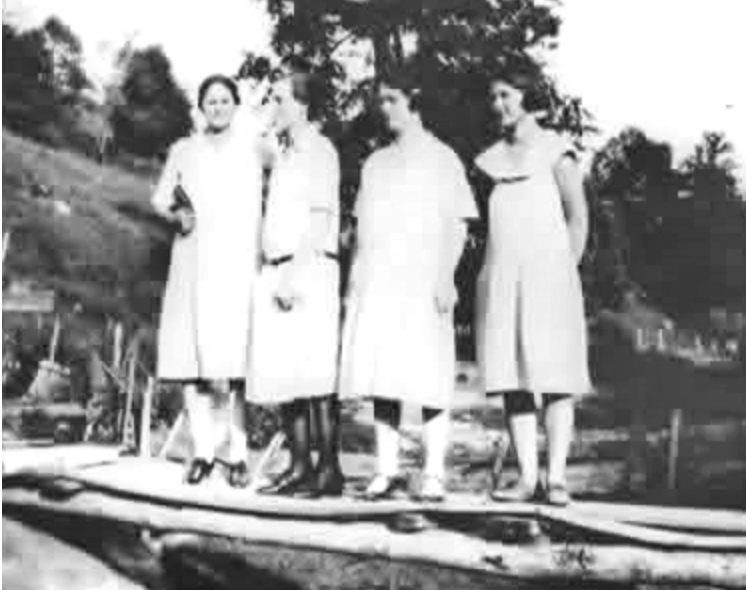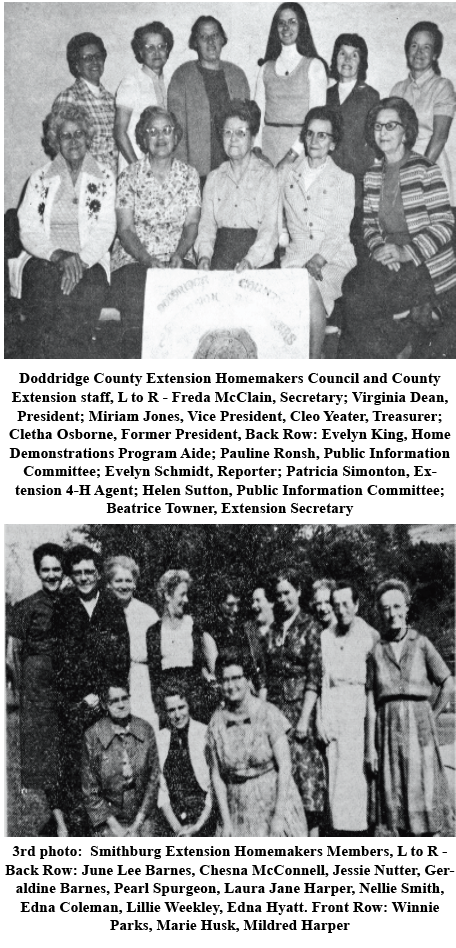
Did you ever wonder what happened to the Extension Homemakers or the Farm Women’s Clubs? You never hear much about them these days. Did they dissolve or just become inactive? Good question… I did some research and discovered some facts you might find remarkably interesting on the subject.
Let’s begin with the beginning. Originally, these homemakers’ clubs were known by several names nationwide including Home Economics Club, Home Bureaus, Home Units, and Home Demonstration Club. Eventually most settled on the name Homemaker Clubs and then Extension Homemakers Club.
The National Extension Homemakers Council (NEHC), otherwise the National Association for Family and Community Education (NAFCE), was established in 1936. The Council’s goal was to nationally organize these homemakers’ clubs and cooperative extension work that began under the Morrill Acts of 1862 signed by President Lincoln which provided funding for the establishment of land-grant universities including West Virginia University and 1890 by Benjamin Harrison which helped establish universities to provide higher education opportunities for African-Americans and others based on the idea that access to education was important for all Americans. These universities were originally created with the goal of educating the state’s population in the areas of agriculture and mechanics as well as the humanities and liberal arts.
In 1914, the Smith-Lever Act was created to establish a cooperative ser vice between the US Department of Agriculture and these land grant colleges to provide demonstrations and education to rural populations not able to attend land-grant universities. This gave way to West Virginia’s first club which was established on December 14, 1914. The club was then called a Farm Women’s Club and was in Monroe County.
Specialists and state home demonstration agents visited local home makers clubs to teach them about homemaking, with the goal of making household chores less time and energy consuming. Traditionally, this type of knowledge was passed down through generations from mother to daughter, or grandmother to granddaughter, and sometimes from another more experienced female in the family to the younger female.
During the early days, travel and communication between our rural com munities was often limited or nonexistent due to the terrible road conditions as well as the lack of leisure time for the women. Socialization was often a greatly anticipated social dinner at church, family weddings, and funerals. Based on these conditions, it is easy to see how local homemakers’ clubs were so welcomed and why they were developed around the purpose of home demonstration work for rural women.
The program became so popular that the extension service began to develop community leaders willing to attend more in-depth training sessions. They would then bring that training back to their local clubs.
By the early 1930s councils throughout the United States realized the need for a national organization. The presidents of twelve state Extension Homemakers organizations met in Columbus, Ohio in September 1935. A committee was created to draft a constitution which would be submitted to the state-wide councils before the next meeting.
When the Extension Homemakers Clubs changed their name for the last time to Community Education Outreach Service in 1998, their mission statement was, “The mission of the West Virginia Community Educational Outreach Service is to strengthen individuals and families through continuing education, leadership development, and community involvement for the betterment of all.
Whether you choose to call them Farm Women’s Club, Extension Homemakers Club, or the Community Education Outreach Service, the clubs’ focus has changed slightly as family household needs have evolved through these past several years, but has always been to educate and develop leadership qualities for the betterment of our communities. For example, at the first part of the 20th century, attention focused on topics like safe food preservation, sewing classes for new homemakers, and other timesaving techniques and were taught by WVU Extension Agents to the club members.
Over the years, topics have changed to include training on such topics as Cast Iron Cooking, Healthy Oils, Barn Quilts, and West Virginia Fairs and Festivals just to name a few. Today many of the lessons focus on heritage, health, and citizenship.
While service was always an important part of the club, today service is one of the main focuses of the group. Some clubs focus on their community centers. Food pantries are another popular project that many of the clubs’ support. CEOS members have made blankets to be given to the new and expecting moms at the Community Baby Shower hosted by Family Resource Networks. Many clubs also collect books and magazines for patient reading material that is distributed to local hospitals and nursing homes, including our nation’s Veterans Hospitals. Some CEOS members enjoy making items for nursing homes, such as lap robes, adult bibs, and walker caddies.
Doddridge County
In my research through the Doddridge County Extension Homemakers and CEOS Scrapbooks that were donated to the Historical Society, I was fortunate enough to identify at least eighteen Extension Homemaker’s Clubs throughout Doddridge County in 1975 and prior to that date. Among those identified were the Big Isaac Extension Homemakers Club, Center Point Extension Homemakers Club, Cornerstone Extension Homemakers Club (West Union), Currydale Extension Homemakers Club (Blandville), Deep Valley Homemakers Club, Fallen Timber-Leopold Homemakers Club (Cove Dist.), Flint Extension Homemakers Club, Greenbrier Extension Homemakers Club, Greenwood Extension Homemakers Club, McClellan Extension Homemakers Club, Miletus Extension Homemakers Club, Mutual Benefit Extension Homemakers Club, Night Owls Extension Homemakers Club (West Union), Oxford Farm Women’s Club, Sedalia Extension Homemakers Club, Sherwood Extension Homemakers Club, Smithburg Extension Homemakers Club (former Smithburg Farm Women’s Club), and St. Clara Extension Homemakers Club.
Cornerstone Extension Homemakers Club was the 2nd club in the county and was organized at the Pine Run School under the direction of the Home Demonstration Council, Miss Adele Biglow, in 1925. Miss Biglow was the one who suggested to name for the club. There were only four members at the 1st meeting, Mrs. E. M. Pratt who was the 1st president, Mrs. J. L. Corathers who was the 1st secretary, Mrs. Hugh H. Smith, and Mrs. Burl Smith.
Flint Extension Homemakers Club was organized on October 15, 1958 at the home of Mrs. Charles Curran. The official name for the club was “Flint Homemakers.” The charter members were Mrs. George Balis, Mrs. Charles Curran, Mrs. Arthur Doak, Mrs. Lawrence Hoskinson, Mrs. Earl Hoskinson, Mrs. James Hoskinson, Mrs. James Nutter, Mrs. Harold Powell, Mrs. Arel Powell, Mrs. Chester Wallace, Mrs. Paul Williams, Mrs. Jack Yerkey, and Mrs. William Yerkey.
Greenwood Extension Homemakers Club was organized by Miss Alice Kissel in 1936. Mrs. Altha Hudkins served on the State Committee for 3 years and as a State Executive Committee for 4 years. She represented Doddridge County as a belle. She and Mrs. Wiseman were charter members of the Greenwood Organization. Prepared by Mrs. Harold Mason, President
Smithburg Extension Homemakers Club was originally called the Smithburg Women’s Club and was organized in or before 1939. In 1941 Mildred Harper and Edna Hyatt organized the Smithburg Extension Homemakers Club with Edna Hyatt as its first president. Mrs. Harper assisted with the Home Demonstration Agent and visited many of the other clubs in the county. In 1945, she was elected Doddridge County Extension Homemakers Club President.
If you should have information on any of the organizations that I did not highlight, please email that information to: [email protected] so that we might add it to our history collection for the new photographic history of Doddridge County book to be available for purchase in the near future.
Today in West Virginia, there are more than 3,500 members participating in this amazing program. They are in all 55 counties and have performed more than 5.6 million hours of service for our communities.
In Doddridge County there are 137 members registered. Though the number is smaller than some of the state’s larger counties, the volunteer work they do is so important. Look for their efforts in this county throughout the year and don’t forget to thank them.
Doddridge County Extension Agent Zona Hutson works tirelessly (often going above and beyond) to bring the many programs to our county. We are blessed to have her support. Also, I like to thank Doddridge County Extension Office Secretary, Kara Edwards, for her assistance during my research for this article. Her patience and professionalism were greatly admired and appreciated.
The value of our CEOS Organizations is priceless. To understand just how priceless, one needs only to visit a hospital, a nursing home, a school, or any of the other areas where there is a need and watch the faces of those receiving the many benefits that would otherwise be impossible to avail to them.
Our deepest thanks and appreciation go out to all the past and present Extension Homemakers, now Community Education Outreach Services. You have been and I’m certain will continue to be one of Doddridge County’s greatest assets.
God Bless and Stay Well
Patricia Richards Harris
Doddridge County Historical Society


